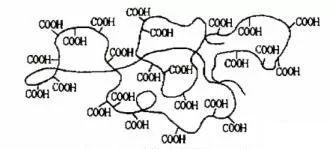Carbomer (Carbonara), also known as carbopol, is a polymer formed by the chemical crosslinking of acrylic acid or acrylate and allyl ether, including polyacrylic acid (homopolymer) and long-chain alkanol acrylates polymers (copolymers). Its molecular structure contains 52~68% acid groups, so it has certain acidity and hydrophilic properties, and can be dissolved in water, ethanol and glycerol. It has been included in the 23rd edition of the US Pharmacopoeia, and has been widely used in the development and production of drugs and cosmetics abroad. It is a multi-purpose polymer material and a promising pharmaceutical excipient.
01 Carbomer traits
Carbopol is a white, loose, hygroscopic powder with a special odor and strong electrostatic effect. Because its structure contains 52%-68% of carboxylic acid groups, it has a certain acidity, its average particle size is 0.2μm, its relative density is 1.4, and its average water content is 8%. It is soluble in ethanol, water and glycerol, and has the characteristics of colloidal solution. The structural diagram of Carbopol in dry powder state is shown in Figure 1.
 02 Carbomer thickening mechanism
There are two main thickening mechanisms of carbomer, including neutralization thickening and bond thickening.
02 Carbomer thickening mechanism
There are two main thickening mechanisms of carbomer, including neutralization thickening and bond thickening.
1. Neutralize and thicken
Since it contains a certain acid group, it needs to be neutralized by alkali in the process of application. After being neutralized by alkali, the carboxyl group of the carboxy resin is ionized. Due to the mutual repulsion of negative charges, the curled molecular chain stretches to a state of great expansion, which increases the original volume to about 1000 times, thereby producing to thickening. In water and other polar solvents, neutralization with NaOH, KOH, NH40H, etc., is easy to generate salts; in acute weak or non-acute solvents, organic amines should be used for neutralization. When the resin is used as an emulsifier, in order to achieve the best stability of the oil/water emulsifier, it is necessary to double neutralize the resin with a water-soluble inorganic base and an oil-soluble organic amine, so that the resin is soluble in water and oil. Salt, acts as a bridge between the oil phase and the water phase.
2. Bond thickening
Carbomer molecules, as carboxyl group donors, can combine with one or more hydroxyl groups to form bonds to thicken, and this reaction mechanism takes time. Commonly used hydroxyl donors include nonionic surfactants, polyols, and the like.
3. Common types of carbomers
Carbopol is a copolymer of polyalkyl sucrose or polyalkyl pentaerythritol and acrylic acid cross-linked polymer. Different materials and degrees of polymerization constitute a variety of products, currently known are Carbopol 910, 934, 934p, 940, 941, 954, 971P, 980, 981 and Carbopol 1342, 1382, 2984, 5984 and so on.
Using Carbomer Summary
1. Carbopol polymers all have the ability of shear thinning, and the longer the time is sheared, the slower the viscosity recovery will be, and even cause the permanent loss of viscosity.
2. Carbopol polymers have poor tolerance to ions, and Carbopol 1342 in the transitional stage is relatively high.
3. Carbomer is not affected by temperature, does not support bacterial and mold growth, and does not have surfactant properties.
4. Ultraviolet irradiation will cause loss of viscosity of Carbopol polymer, and this loss is irreversible.
Get a Quote for Carbomer 980 here
More Details:
Cosmetic Thickener - Carbomer 980
Certificate of Analysis - Carbomer 980
Hot tags: Carbomer; Carbomer 980; carbopol; carbopol 980; carbopol powder; carbomer ingredient; carbopol price; carbomer powder; carbomer price; China carbopol powder supplier; China carbopol powder factory; China carbopol powder Manufacturer; China carbomer powder supplier; China carbomer powder factory; China carbomer powder Manufacturer.
